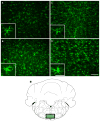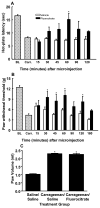Glial activation in the rostroventromedial medulla promotes descending facilitation to mediate inflammatory hypersensitivity
- PMID: 19614984
- PMCID: PMC5693227
- DOI: 10.1111/j.1460-9568.2009.06813.x
Glial activation in the rostroventromedial medulla promotes descending facilitation to mediate inflammatory hypersensitivity
Abstract
Substantial evidence shows that activation of glial cells in the spinal cord may promote central sensitization and pain. Descending facilitation from the rostroventromedial medulla (RVM) is a critical component in the maintenance of chronic pain states, although the precise mechanisms through which facilitation maintains pain are unclear. Here, we investigated the possibility that glial activation in the RVM could promote descending facilitation from the RVM in states of inflammatory pain. Peripheral inflammation was induced with carrageenan injected into the hindpaws of male Sprague-Dawley rats, and behavioral responses to noxious thermal and light tactile stimuli were determined. Microinjection of the glial inhibitors minocycline or fluorocitrate, or of the p38 mitogen-activated protein kinase (MAPK) inhibitor SB 203580, produced a significant and time-related attenuation of behavioral hypersensitivity resulting from hindpaw inflammation. Carrageenan-induced inflammation increased immunolabeling for microglia and astrocytes in the RVM, as well as for phosphorylated p38 MAPK. Phosphorylated p38 MAPK was found in microglia and neurons of the RVM. Inflammation-induced microglial and astrocytic activation in the RVM were attenuated by RVM microinjection of the glial inhibitors. The data show that inflammatory pain is associated with glial activation in the RVM that probably participates in driving descending pain facilitation. These findings reveal a novel site of glial modulation of inflammatory pain.
Figures








Similar articles
-
Glial activation in the periaqueductal gray promotes descending facilitation of neuropathic pain through the p38 MAPK signaling pathway.J Neurosci Res. 2016 Jan;94(1):50-61. doi: 10.1002/jnr.23672. Epub 2015 Oct 1. J Neurosci Res. 2016. PMID: 26423029
-
Inhibition of glial activation in rostral ventromedial medulla attenuates mechanical allodynia in a rat model of cancer-induced bone pain.J Huazhong Univ Sci Technolog Med Sci. 2012 Apr;32(2):291-298. doi: 10.1007/s11596-012-0051-5. Epub 2012 Apr 20. J Huazhong Univ Sci Technolog Med Sci. 2012. PMID: 22528236
-
Supraspinal glial-neuronal interactions contribute to descending pain facilitation.J Neurosci. 2008 Oct 15;28(42):10482-95. doi: 10.1523/JNEUROSCI.3593-08.2008. J Neurosci. 2008. PMID: 18923025 Free PMC article.
-
Pain modulation from the brain during diabetic neuropathy: Uncovering the role of the rostroventromedial medulla.Neurobiol Dis. 2016 Dec;96:346-356. doi: 10.1016/j.nbd.2016.10.002. Epub 2016 Oct 4. Neurobiol Dis. 2016. PMID: 27717882 Review.
-
Induction of pain facilitation by sustained opioid exposure: relationship to opioid antinociceptive tolerance.Life Sci. 2003 Jun 27;73(6):783-800. doi: 10.1016/s0024-3205(03)00410-7. Life Sci. 2003. PMID: 12801599 Review.
Cited by
-
Activation of mitogen-activated protein kinase in descending pain modulatory system.J Signal Transduct. 2011;2011:468061. doi: 10.1155/2011/468061. Epub 2010 Dec 1. J Signal Transduct. 2011. PMID: 21637376 Free PMC article.
-
Regulation of Pleiotrophin, Midkine, Receptor Protein Tyrosine Phosphatase β/ζ, and Their Intracellular Signaling Cascades in the Nucleus Accumbens During Opiate Administration.Int J Neuropsychopharmacol. 2015 Jul 11;19(1):pyv077. doi: 10.1093/ijnp/pyv077. Int J Neuropsychopharmacol. 2015. PMID: 26164717 Free PMC article.
-
Injury induced activation of extracellular signal-regulated kinase (ERK) in the rat rostral ventromedial medulla (RVM) is age dependant and requires the lamina I projection pathway.Mol Pain. 2010 Sep 14;6:54. doi: 10.1186/1744-8069-6-54. Mol Pain. 2010. PMID: 20840753 Free PMC article.
-
Neuronal and microglial mechanisms of neuropathic pain.Mol Brain. 2011 Jul 30;4:31. doi: 10.1186/1756-6606-4-31. Mol Brain. 2011. PMID: 21801430 Free PMC article. Review.
-
Differential activation of spinal and parabrachial glial cells in a neuropathic pain model.Front Cell Neurosci. 2023 Apr 4;17:1163171. doi: 10.3389/fncel.2023.1163171. eCollection 2023. Front Cell Neurosci. 2023. PMID: 37082205 Free PMC article.
References
-
- Chacur M, Gutierrez JM, Milligan ED, Wieseler-Frank J, Britto LR, Maier SF, Watkins LR, Cury Y. Snake venom components enhance pain upon subcutaneous injection: an initial examination of spinal cord mediators. Pain. 2004;111:65–76. - PubMed
-
- Chaplan SR, Bach FW, Pogrel JW, Chung JM, Yaksh TL. Quantitative assessment of tactile allodynia in the rat paw. J Neurosci Methods. 1994;53:55–63. - PubMed
-
- Colburn RW, DeLeo JA, Rickman AJ, Yeager MP, Kwon P, Hickey WF. Dissociation of microglial activation and neuropathic pain behaviors following peripheral nerve injury in the rat. J Neuroimmunol. 1997;79:163–175. - PubMed
Publication types
MeSH terms
Grants and funding
LinkOut - more resources
Full Text Sources
Medical

